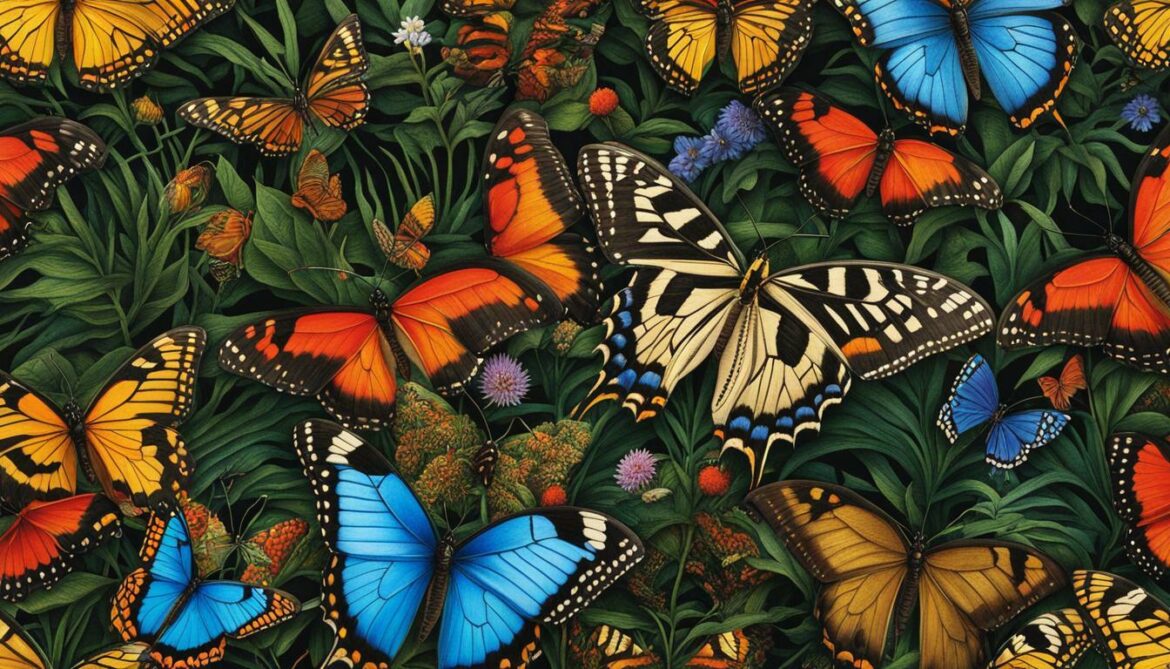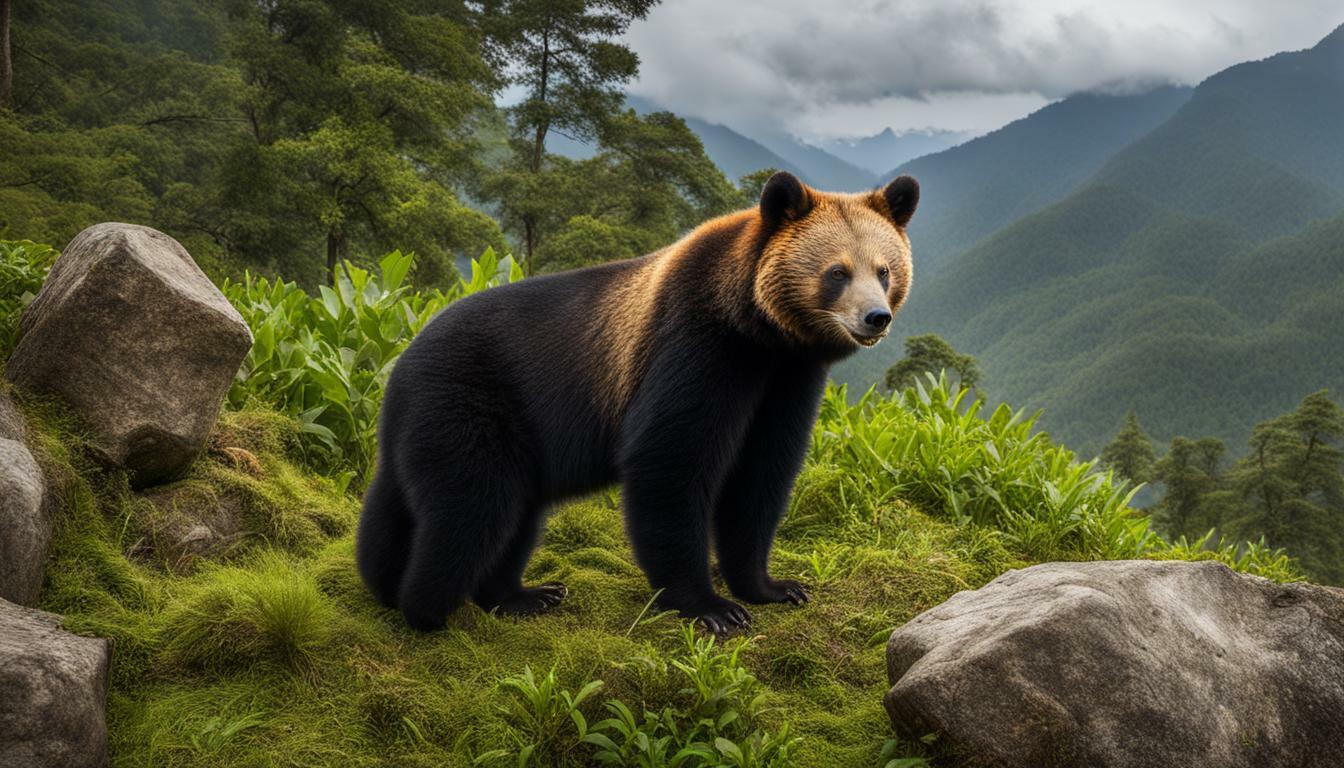Bhutan is located in the Eastern Himalayas and is recognized as a global biodiversity hotspot, boasting a diverse array of plant and animal species. The country is home to six major agro-ecological zones, each corresponding to different altitudinal ranges and climatic conditions. With vast forest cover and abundant inland water resources, Bhutan supports a rich and dense population of flora and fauna.
Key Takeaways:
- Bhutan is a global biodiversity hotspot, known for its rich and diverse ecosystems.
- The country has a vast forest cover, comprising 70.46% of the total land area.
- Bhutan is home to over 5,600 species of flowering plants, close to 200 species of mammals, and 678 bird species.
- Main threats to Bhutan’s biodiversity include land conversion, overexploitation, climate change, and forest fires.
- Bhutan has implemented conservation measures, including the establishment of protected areas, to safeguard its biodiversity.
The Richness of Bhutan’s Flora and Fauna
Bhutan is home to a staggering 5,603 flowering plant species, close to 200 species of mammals, and 678 recorded bird species. Its diverse flora and fauna make it a global biodiversity hotspot, located in the Eastern Himalayas. The country’s agro-ecological zones, ranging from alpine to subtropical, support a wide range of plant and animal life.
Among the flowering plants, Bhutan boasts an impressive variety of crops, including cereals like rice, maize, and barley, as well as fruits, vegetables, and spices. The lush forests, covering 70.46% of the land, provide habitat for mammals such as the Red Panda, Gee’s Golden Langur, and Alpine Musk Deer. The rivers and water resources support a rich diversity of freshwater fish species, while the skies are filled with 678 bird species, including resident, migratory, and winter visitors.
It’s important to note that Bhutan’s biodiversity extends beyond the more well-known species. Smaller plants, insects, and invertebrates play a crucial role in supporting ecosystems as pollinators, nutrient recyclers, and food sources for other creatures. However, there is still limited documentation and understanding of these species, leaving a knowledge gap in Bhutan’s conservation strategy.
| Flora |
Number of Species |
| Flowering Plants |
5,603 |
| Crops |
About 80 |
| Animals |
200 species of mammals
678 species of birds
50 species of freshwater fish |

Despite these challenges, Bhutan has been proactive in its conservation efforts. With more than half of its landmass designated as protected areas, including the establishment of the Bhutan Biological Conservation Complex, the country is committed to preserving its natural heritage. Bhutan’s efforts to integrate biodiversity targets into national plans and develop Biodiversity Action Plans have contributed to the establishment of a strong protected areas system, safeguarding its rich biodiversity for future generations.
However, there is still much work to be done to fully understand and conserve Bhutan’s lesser-known species. Increased research and scientific studies, combined with the implementation of sustainable development practices, will be crucial in addressing the knowledge gaps and protecting the intricate web of life that exists in Bhutan.
Quote
“While Bhutan is projected as a country with a rich biodiversity, there is limited data to back the statement.” – Choki Gyeltshen, Senior Researcher, National Biodiversity Centre (NBC)
Threats to Bhutan Biodiversity
Despite its rich biodiversity, Bhutan’s ecosystems face numerous threats, including habitat loss, overexploitation of resources, and the impact of climate change. These threats pose a significant risk to the diverse flora and fauna that call Bhutan home.
Land conversion is one of the major threats to Bhutan’s biodiversity. As the country develops and expands its infrastructure, forests and natural habitats are being cleared to make way for agriculture, urbanization, and industrialization. This loss of habitat can have a devastating impact on the plant and animal species that rely on these ecosystems for survival.
Overexploitation of resources is another significant threat. With a rural population heavily dependent on farming and forest resources, there is a growing demand for timber, fuelwood, and non-wood forest products. Unsustainable harvesting practices, such as illegal logging, can lead to the depletion of tree species and disrupt the delicate balance of the ecosystem.
Climate change is also a pressing concern for Bhutan’s biodiversity. Rising temperatures and changing weather patterns can disrupt the natural habitats and migration patterns of species. This can result in the loss of biodiversity and the decline of vulnerable species, such as the Gee’s Golden Langur and the Red Panda.
In addition to these direct threats, forest fires pose a significant risk to Bhutan’s ecosystems. With the increase in dry seasons and the spread of wildfires, forests and their inhabitants are at risk of destruction. These fires not only destroy habitats but also release large amounts of carbon dioxide into the atmosphere, contributing to climate change.
Table: Threats to Bhutan Biodiversity
| Threat |
Description |
| Land conversion |
Clearing of forests and natural habitats for agriculture, urbanization, and industrialization. |
| Overexploitation of resources |
Unsustainable harvesting practices, such as illegal logging, leading to depletion of tree species and disruption of ecosystems. |
| Climate change |
Rising temperatures and changing weather patterns disrupting habitats and migration patterns of species. |
| Forest fires |
Increased risk of wildfires destroying habitats and releasing carbon dioxide into the atmosphere. |
Quote: “While Bhutan is projected as a country with rich biodiversity, there is limited data to back the statement.” – Choki Gyeltshen, senior researcher with the National Biodiversity Centre (NBC).
Bhutan, known for its proactive initiatives in environmental conservation, recognizes the importance of protecting its unique biodiversity. Efforts have been made to establish protected areas, which cover a significant portion of the country’s land area, and integrate biodiversity targets into national plans. However, more needs to be done to address the ongoing threats and ensure the long-term sustainability of Bhutan’s ecosystems.
By implementing sustainable practices, raising awareness about the value of biodiversity, and fostering collaborations between government, communities, and conservation organizations, Bhutan can continue to be a leader in wildlife conservation and protect its precious ecosystems for future generations.
Conservation Efforts in Bhutan
Bhutan has made significant efforts to conserve its biodiversity, with more than 42% of its land designated as protected areas and a focus on sustainable development practices. The country’s proactive initiatives in environmental conservation have earned it a reputation as a world leader in preserving biodiversity.
The protected areas in Bhutan cover a wide range of ecosystems, from subtropical forests and savannah grasslands in the southern foothills to alpine meadows in the north. With a forest cover of 71% and designated biological corridors comprising an additional 8.60% of the country’s land area, Bhutan boasts an astounding diversity of flora and fauna. The Biodiversity Statistics of Bhutan 2017 lists at least 736 species of birds, 129 species of mammals, and 5,369 species of plants.
One of the key achievements in Bhutan’s conservation efforts is the establishment of protected areas that represent all major ecosystems found in the country. These protected areas, encompassing 42.70% of the land area along with biological corridors, form a macro-level natural landscape called the “Bhutan Biological Conservation Complex” (B2C2). They provide vital habitats for threatened and endangered species such as the Red Panda, Gee’s Golden Langur, Alpine Musk Deer, and snow leopards.
| Species |
Conservation Status |
| Red Panda |
Endangered |
| Gee’s Golden Langur |
Endangered |
| Alpine Musk Deer |
Endangered |
| Snow Leopards |
Endangered |
In addition to protected areas, Bhutan has also implemented strategies to control the unsustainable harvesting of medicinal plants, conserve tiger populations through the Tiger Action Plan, and mitigate the impact of climate change on biodiversity. The country’s commitment to sustainable development is reflected in its plans to develop national targets in line with the Aichi Biodiversity Targets and incorporate them into the Biodiversity Action Plan.
“While Bhutan is projected as a country with rich biodiversity, there is limited data to back the statement,” said Choki Gyeltshen, senior researcher with the National Biodiversity Centre (NBC).
Challenges and Future Actions
Despite Bhutan’s impressive conservation efforts, there are still challenges to overcome. Limited funding and resources, along with a lack of documentation on smaller plants and insects, have hindered comprehensive research and understanding of Bhutan’s biodiversity. Climate change also poses a threat to the country’s ecosystems, with invasive species encroaching on native vegetation.
To address these challenges, Bhutan needs to prioritize scientific studies and research, gather more data on lesser-known species, and enhance its understanding of the interactions between various organisms and the environment. With its commitment to sustainable development and conservation, Bhutan has the potential to continue leading the way in biodiversity protection and set an example for other nations to follow.

Summary:
- Bhutan has designated over 42% of its land as protected areas, forming a macro-level natural landscape known as the “Bhutan Biological Conservation Complex” (B2C2).
- The country focuses on sustainable development practices and has implemented strategies to control unsustainable harvesting of medicinal plants and conserve threatened species such as tigers.
- Bhutan’s diverse ecosystems support a wide range of flora and fauna, including endangered species like the Red Panda, Gee’s Golden Langur, and Alpine Musk Deer.
- Challenges include limited funding for biodiversity research, lack of documentation on smaller plants and insects, and the impact of climate change.
- Future actions should prioritize scientific studies, gather more data on lesser-known species, and enhance understanding of the interactions between organisms and the environment.
“More focus needs to be given to science and studies now due to climate change and urbanization, in fact we are lagging behind,” said Rinchen Yangzom, a botanist with the National Biodiversity Centre (NBC).
Conclusion
Bhutan’s rich biodiversity is not only a national treasure but also plays a vital role in supporting livelihoods, enhancing food security, and providing valuable ecosystem services. Situated in one of the most biodiverse regions in the world, Bhutan boasts an astounding diversity of flora and fauna, with over 5,600 flowering plant species, close to 200 mammal species, and 678 bird species.
However, this unique biodiversity is under threat from various factors, including land conversion, overexploitation, climate change, and forest fires. These threats pose significant challenges to the conservation of Bhutan’s ecosystems and the protection of its diverse species.
Despite these challenges, Bhutan has implemented several measures to enhance the conservation of its biodiversity. The country has established protected areas covering 42.70% of its land area and implemented biodiversity action plans. Bhutan’s commitment to sustainable development and environmentally friendly practices is evident in its forest cover of 70.46% and the incorporation of biodiversity targets into national plans.
Continued conservation efforts are crucial for the future of Bhutan’s biodiversity. By protecting its ecosystems and promoting sustainable practices, Bhutan can ensure the preservation of its rich wildlife and plant species for generations to come. The conservation of Bhutan’s biodiversity is not only important for the country but also contributes to global efforts in wildlife conservation and protecting our planet’s natural heritage.
FAQ
Q: What is the biodiversity like in Bhutan?
A: Bhutan is known for its rich biodiversity, boasting an astounding diversity of flora and fauna. The country is home to numerous plant and animal species, including flowering plants, mammals, birds, and fish.
Q: What are the main threats to Bhutan’s biodiversity?
A: The main threats to Bhutan’s biodiversity include land conversion, overexploitation, climate change, and forest fires. These factors pose a risk to the diverse ecosystems and species found in the country.
Q: What conservation efforts are being made in Bhutan?
A: Bhutan has implemented various measures to protect and conserve its biodiversity. This includes the establishment of protected areas, incorporation of biodiversity targets into national plans, and initiatives to control unsustainable practices and preserve vulnerable species.
Q: Why is it important to conserve biodiversity in Bhutan?
A: Biodiversity is intricately linked to livelihoods in Bhutan, playing a crucial role in enhancing food security, economic development, and providing ecosystem services such as clean air and water. Conserving biodiversity is essential for the sustainable development of the country.
Q: What are the ongoing research efforts in Bhutan to understand its biodiversity?
A: Bhutan is working towards gathering more scientific data on its lesser-known species, particularly insects, smaller plants, and microorganisms. This research helps in understanding the roles these species play in supporting ecosystems and addressing potential risks.
Source Links




















Post comments (0)